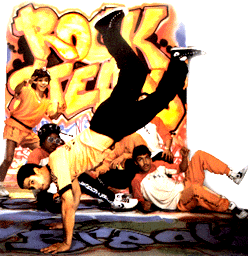INTRODUCTION

The development of rock and roll music in the 1950's and aspects of rock music in the 1960's can be compared to the emergence and development of rap and hip-hop music in the 1980's, certainly in relation to the black community in the United States. As we hope you will recall, rock and roll developed from rhythm and blues, which had a long tradition among African-American people.
In the 1950's, white radio stations and record companies wanted to capitalize on and manipulate the black sound without actually having blacks perform the music. In the 1960's, record companies including Motown, which was owned and managed by black people, tried to capitalize on the appeal that black music had to the white audience and tailored and marketed their music to a largely white group of fans. By the time that rap and hip-hop developed, things had changed dramatically.
In the 1980's and especially the 1990's, the rap music industry wanted to have a sound that was entirely their own - with no appropriations or limitations, and certainly no apologies. Rap music has been black run and black created. Unlike Motown, record labels like Def Jam, Bad Boy, and Death Row did not cater to a white audience at all, although the music eventually found an audience among white people and has become one of the most popular types of music in recent years. In fact, in 1998, rap outsold every other genre on music, including country, selling 81 million CDs and tapes. The influence that rap has had on rock has been intense and some of the most interesting music of the early 21st century is either rap, based on rap, or influenced by rap.
Although we use the terms "rap" and "hip-hop" interchangeably, strictly speaking, rap is a form of rhythmic speaking in rhyme, which in the world of music goes all the way back to the rhyming "jive talk" of the Bebop jazz musicians. Hip-hop, on the other hand, is the backing music for rap, which is often composed of a collage of excerpts or samples from other songs. Basically, hip-hop deconstructs familiar sounds and songs from earlier music, and builds those sounds into entirely new, often unpredictable songs. Hip-hop also refers to the culture and styles surrounding rap music. James Brown, Sly Stone, and George Clinton of Parliament/Funkadelic are early influences on hip-hop.
 Rap
began in 1971, in the Bronx, with Kool Herc, who was from Jamaica.
At block parties, Kool Herc would play two turntables by hand and
manipulate the sound to create an entirely new sound, while he rapped the
lyrics from the song he was playing. The "break", or
instrumental part of the record was played repeatedly and this became his
background music. Since he did not think that Americans would get reggae,
he used the break from American funk music, like James
Brown. He also employed dancers, who became known as break
dancers or b-boys.
Rap
began in 1971, in the Bronx, with Kool Herc, who was from Jamaica.
At block parties, Kool Herc would play two turntables by hand and
manipulate the sound to create an entirely new sound, while he rapped the
lyrics from the song he was playing. The "break", or
instrumental part of the record was played repeatedly and this became his
background music. Since he did not think that Americans would get reggae,
he used the break from American funk music, like James
Brown. He also employed dancers, who became known as break
dancers or b-boys.
Grandmaster Flash, who heard Kool Herc perform, thought he could do it better and he started stretching the break, created new sounds by scratching the records and sometimes playing them backwards. Like John Cage and Jimi Hendrix, he pushed the sounds that a turntable, a needle and a record could make. He could not rap, so he got together a group called the Furious Five to rap to his scratching. The first rap group to have a hit record was the Sugarhill Gang.
These early rap groups are now called "old school." As rap developed, elements from rock music such as electric guitars and intense drumbeats were introduced by Run-D.M.C., which was the first hardcore rap group, and the earlier scratching was replaced by sampling, an electronic pulling of sounds from earlier music. Public Enemy developed a very sophisticated sampling technique, which often was based on a blend of white noise, strong beats, and unrecognizable samples. Just as importantly, or perhaps even more importantly, they introduced social and political elements from the black community into their music.
This developed in the 1990's into gangsta rap, which was originally introduced by NWA. Gangsta rap emphasized violence, crime and sex, and for that reason, has been the most controversial type of rap. Among the important gangsta rappers were Snoop Doggy Dog, Tupac, and the Notorious B.I.G. The first white group to gain acceptance in rap music was the New York based Beastie Boys. At first called cultural pirates by some critics, they led the way for a number of white rap acts, including today's major music center of controversy, Eminem. First the Fugees and then their lead singer Lauryn Hill, took rap in another direction, most recently blending elements of rap and hip-hop with R&B.*
* developed from lecture notes written by Lisa Smith for Art Education 160, 1999.
